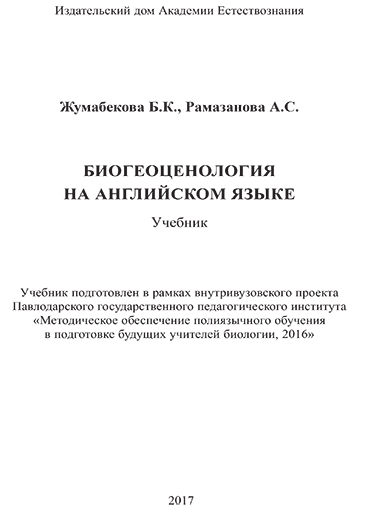
Научная электронная библиотека
Монографии, изданные в издательстве Российской Академии Естествознания
Chapter 9. THE SUSTAINABILITY AND DYNAMICS OF A BIOGEOCENOSIS
|
Essential targets: By the end of this chapter you should be able to: Discuss the properties of a biogeocenosis: stability, resistance, instability; Distinguish the stages of succession in a biogeocenosis; Characterize the climax community. |
Read the given text, divide it to the parts and give the title for each parts / Мәтінді оқып шығыңдар, оны бөліктерге бөліңдер және әрбір бөлікке атау беріңдер / Прочитайте текст, разделите его на части и дайте название для каждой части.
Biogeocenosis are characterized by ecological stability, which is caused by the fact that the modern natural biogeocenosis are the result оf a protracted and profound adaptation of the living components to each other and to the components of the inert environment. For this reason, biogeocenosis which have been removed from a stable state by one or another cause can be restored in a form close to the original after the elimination of this cause [1].
Ecological stability can be defined as the ability of a community to defy change or rebound from change [2].
The Principles of biogeocenosis Stability are:
biogeocenoses dispose of waste and replenish nutrients by recycling all elements.
biogeocenoses use sunlight as their source of energy.
the size of a consumer population is maintained such that overgrazing and other forms of overuse do not occur.
biodiversity is maintained.
Factors influencing biogeocenosis stability are biotic potential and environmental resistance. This could be in the form of: positive and negative factors of population growth either abiotic or biotic (Table 1), species diversity that is highly correlated with stability, as well as climate.
Table 1. List of biotic and abiotic factors
|
Biotic factors |
Abiotic factors |
|
nutrients (plants) |
light |
|
food (animals) |
pH |
|
territory |
salinity |
|
predation |
temperature |
|
ability to defend |
chemical environment |
|
suitable habitat |
|
|
water supply |
|
|
birth control |
|
|
parasites |
|
|
mating behavior war |
|
|
social stress |
|
|
ability to migrate |
|
|
hierarchy disease |
|
|
competitors |
Stability of a biogeocenosis also needs to have a resistance to change. This resistance to change has three forms: inertia – the resistance to change, resilience – the ability to recover from change and succession – the replacement of species by another [3].
A biogeocenosis is a dynamic system. Its continuous change and development is the result of the internal contradictory tendencies of its components. The changes in a biogeocenosis can be temporary, caused by easily reversible (daily, weather, and seasonal) reactions of the components in the biogeocenosis, or profound, leading to irreversible changes in the state, structure, and general metabolism of the biogeocenosis and marking a change (ecological succession) from one biogeocenosis to another. The changes can be slow or rapid; the latter often occur under the effect of sudden changes as a result of natural causes or the economic activity of man, who not only transforms and destroys the natural biogeocenosis, but also creates new cultural ones [4].
Ecological succession is the process of change in the species structure of an ecological community over time. The time scale can be decades (for example, after a wildfire), or even millions of years after a mass extinction [5].
The community begins with relatively few pioneering plants and animals and develops through increasing complexity until it becomes stable or self-perpetuating as a climax community. The ʺengineʺ of succession, the cause of ecosystem change, is the impact of established species upon their own environments. A consequence of living is the sometimes subtle and sometimes overt alteration of one’s own environment [5].
It is a phenomenon or process by which an ecological community undergoes more or less orderly and predictable changes following a disturbance or the initial colonization of a new habitat. Succession may be initiated either by formation of new, unoccupied habitat, such as from a lava flow or a severe landslide, or by some form of disturbance of a community, such as from a fire, severe wind throw, or logging. Succession that begins in new habitats, uninfluenced by pre-existing communities is called primary succession (Fig.10), whereas succession that follows disruption of a pre-existing community is called secondary succession (Fig.11) [5].
There are an autogenic succession and an allogenic succession in a biocenosis depending on the causes of change in ecological communities.
Autogenic succession can be brought by changes in the soil caused by the organisms there. These changes include accumulation of organic matter in litter or humic layer, alteration of soil nutrients, change in pH of soil by plants growing there. The structure of the plants themselves can also alter the community. For example, when larger species like trees mature, they produce shade on to the developing forest floor that tends to exclude light-requiring species. Shade-tolerant species will invade the area.
Allogenic succession is caused by external environmental influences and not by the vegetation. For example, soil changes due to erosion, leaching or the deposition of silt and clays can alter the nutrient content and water relationships in the ecosystems. Animals also play an important role in allogenic changes as they are pollinators, seed dispersers and herbivores. They can also increase nutrient content of the soil in certain areas, or shift soil about (as termites, ants, and moles do) creating patches in the habitat. This may create regeneration sites that favor certain species.
Climatic factors may be very important, but on a much longer time-scale than any other. Changes in temperature and rainfall patterns will promote changes in communities. As the climate warmed at the end of each ice age, great successional changes took place. The tundra vegetation and bare glacial till deposits underwent succession to mixed deciduous forest.
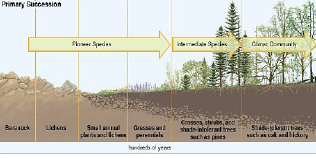
Figure 10. Primary succession begins in barren areas,
such as on bare rock exposed by a retreating glacier … [6]
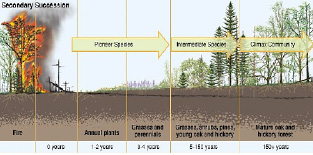
Figure 11. Secondary succession follows a major disturbance,
such as a fire or a flood [6]
The greenhouse effect resulting in increase in temperature is likely to bring profound Allogenic changes in the next century. Geological and climatic catastrophes such as volcanic eruptions, earthquakes, avalanches, meteors, floods, fires, and high wind also bring allogenic changes [7].
Glossary of essential terms / Негізгі терминдер глоссарийі / Глоссарий основных терминов
|
№ |
English term |
Kazakh equivalent |
Russian equivalent |
|
1 |
protracted |
ұзақ |
длительный |
|
2 |
profound |
терең |
глубокий |
|
3 |
elimination |
жою |
устранение |
|
4 |
replenish |
толықтыру |
пополнять |
|
5 |
overuse |
теріс пайдалану |
злоупотреблять |
|
6 |
resistance |
қарсыласу |
сопротивление |
|
7 |
predictable |
болжанған |
предсказуемый |
|
8 |
flood |
тасқын |
наводнение |
|
9 |
avalanche |
көшкін |
лавина |
|
10 |
fire |
өрт |
пожар |
|
Questions: What is an ecological stability? How is the ecological stability supported? How was developed the concept of stability-diversity of a community? What is mean the phrase “A biogeocenosis is a dynamic system”? What kind of changes are there in a biogeocenosis? What is primary succession? How does a secondary succession begin in a biogeocenosis? What are an autogenic succession and an allogenic succession in a biogeocenosis? |
|
Key phrases and sentences / Түйінді сөздер мен сөйлемдер / Ключевые фразы и предложения 1. An ecological stability is a ... / Экологиялық тұрақтылық бұл …/ Экологическая стабильность – это … 2. There are following biotic and abiotic factors: … / Биотикалық және абиотикалық факторлар: …/ Выделяют следующие биотические и абиотические факторы: … 3. A biogeocenosis is a … system/ Биогеоценоз – … экожүйе/ Биогеоценоз – … система. |
|
4. A biogeocenosis continuous … and develops/ Биогеоценоз үнемі ... және …/ Биогеоценоз постоянно … и ... 5. An ecological succession is the process of ..../ Экологиялық сукцессия дегеніміз …/ Экологическая сукцессия – это процесс ... 6. There are following types of ecological successions in a biocenosis:…/ Экологиялық сукцессияның биоценоздағы түрлері: …/ Выделяют следующие типы экологических сукцессий в биоценозе: … |
I. Multiple Choice. Identify the letter of the choice that best completes the statement or answers the question / Тест. Тұжырымдаманы дұрыс аяқтайтын немесе сұраққа жауап беретін әріпті белгілеңдер / Тест. Укажите букву, которая наилучшим образом завершает данное утверждение или отвечает на вопрос.
1. As succession proceeds, _________
a. species diversity decreases and food web complexity increases.
b. species diversity increases and food web complexity increases.
c. stability increases and food web complexity decreases.
d. species diversity decreases and community productivity increases.
e. stability increases and food web complexity increases.
2. In contrast to earlier communities, climax communities ________
a. are relatively unstable.
b. are more species diverse.
c. contain faster growing species.
d. are more productive.
e. exhibit primarily density-independent controls.
3. If Federal funding or land is involved in any major construction projects an analysis of the potential impacts is mandated in the form of a/an _______
a. environmental impact statement.
b. environmental interests proposal.
c. environmental protection plan.
d. environmental solutions analysis.
e. conservation impact statement.
4. The main factors in population growth are _____
a. predators and disease.
b. limiting factors.
c. the reproductive rate and recruitment.
d. birth rate and death rate.
e. environmental resistance.
5. Which of the following statements is true?
a. mutations are always harmful.
b. Darwin incorporated Mendel’s genetics into his theory of natural selection.
c. humans possess no more than 10,000 genes.
d. genes are the source of individual variation.
e. none of the above.
II. Put the pictures in the correct sequence. Give the comments on the result / Суреттерді дұрыс бірізділікте қойыңдар. Нәтижені түсіндіріңдер / Расставьте рисунки в правильной последовательности. Прокомментируйте результат.
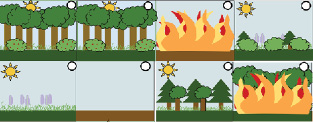
III. Read the text. Make a structure plan of the text. Retell the text using the plan / Мәтінді оқып шығыңдар. Мәтіннің құрылымдық жоспарын құрыңдар. Жоспарды пайдалана отырып мәтінді мазмұндаңдар / Прочитайте текст. Составьте структурный план текста. Перескажите текст, используя план.
The final or stable community in a biocenosis is the climax community or climatic vegetation. It is self-perpetuating and in equilibrium with the physical habitat. There is no net annual accumulation of organic matter in a climax community. The annual production and use of energy is balanced in such a community.
Characteristics of climax community:
• The vegetation is tolerant of environmental conditions.
• It has a wide diversity of species, a well-drained spatial structure, and complex food chains.
• The climax ecosystem is balanced. There is equilibrium between gross primary production and total respiration, between energy used from sunlight and energy released by decomposition, between uptake of nutrients from the soil and the return of nutrient by litter fall to the soil.
• Individuals in the climax stage are replaced by others of the same kind. Thus the species composition maintains equilibrium.
• It is an index of the climate of the area. The life or growth forms indicate the climatic type.
Types of climax:
Climatic Climax
If there is only a single climax and the development of climax community is controlled by the climate of the region, it is termed as climatic climax. For example, development of Maple-beech climax community over moist soil. Climatic climax is theoretical and develops where physical conditions of the substrate are not so extreme as to modify the effects of the prevailing regional climate.
Edaphic Climax
When there are more than one climax communities in the region, modified by local conditions of the substrate such as soil moisture, soil nutrients, topography, slope exposure, fire, and animal activity, it is called edaphic climax. Succession ends in an edaphic climax where topography, soil, water, fire, or other disturbances are such that a climatic climax cannot develop.
Catastrophic Climax
Climax vegetation vulnerable to a catastrophic event such as a wildfire. For example, in California, chaparral vegetation is the final vegetation. The wildfire removes the mature vegetation and decomposers. A rapid development of herbaceous vegetation follows until the shrub dominance is re-established. This is known as catastrophic climax.
Disclimax
When a stable community, which is not the climatic or edaphic climax for the given site, is maintained by man or his domestic animals, it is designated as Disclimax (disturbance climax) or anthropogenic subclimax (man-generated). For example, overgrazing by stock may produce a desert community of bushes and cacti where the local climate actually would allow grassland to maintain itself.
Subclimax
The prolonged stage in succession just preceding the climatic climax is subclimax.
Preclimax and Postclimax
In certain areas different climax communities develop under similar climatic conditions. If the community has life forms lower than those in the expected climatic climax, it is called preclimax; a community that has life forms higher than those in the expected climatic climax is postclimax. Preclimax strips develop in less moist and hotter areas, whereas Postclimax strands develop in more moist and cooler areas than that of surrounding climate.
IV. Fill in the table / Кестені толтырыңдар / Заполните таблицу.
A Comparison of Immature and Mature biogeocenosis
|
Characteristic |
Immature |
Mature |
|
Food chains |
Web-like, mostly detritus |
|
|
Food webs |
Simple |
|
|
Populations |
Stable |
|
|
Decomposers |
Few |
|
|
Annual plant size |
Large |
|
|
Net productivity |
High |
|
|
Species diversity |
High |
|
|
Niche specialization |
Broad |
|
|
Nutrient cycles |
Closed |
|
|
Conclusion. Differences between Immature and Mature Ecosystems. |
||
V. Build a small ecosystem and make a mold terrarium, watch tiny blue, green and white plants grow on leftover food. Make a conclusion about the results of work / Кіші-гірім экожүйе құрыңдар және зеңі бар террариум жасаңдар, тамақ қалдықтарында өсетін ұсақ көгілдір, жасыл және ақ өсімдіктерді қараңдар. Жұмыс нәтижелері бойынша қорытынды жасаңдар / Постройте небольшую экосистему и сделайте террариум с плесенью, посмотрите крошечные голубые, зеленые и белые растения, растущие на остатках пищи. Сделайте вывод о результатах работы.
|
SUMMARY Ecological stability is the ability of a community to defy change or rebound from change. |
|
The existing interactions between the various living beings go along with a permanent mixing of mineral and organic substances, absorbed by organisms for their growth, their maintenance and their reproduction, to be finally rejected as waste. These permanent recyclings of the elements (in particular carbon, oxygen and nitrogen) as well as the water are called biogeochemical cycles. They guarantee a durable stability of the biosphere (at least when unchecked human influence and extreme weather or geological phenomena are left aside). This self-regulation, supported by negative feedback controls, ensures the ongoing of the ecosystems. It is shown by the very stable concentrations of most elements of each compartment. This is referred to as homeostasis. The ecosystem also tends to evolve to a state of ideal balance, reached after a succession of events, the climax. |
 Topics for an essay:
Topics for an essay:
1. The sustainability of a biogeocenosis.
2. Biotic factors of the environment.
3. Abiotic factors of the environment.
4. Mechanisms stability of the biogeocenosis.
5. Ecological succession as process of following in order or sequence.
6. Dynamics of phytocenosis.
7. Types of fluctuations.
8. The theory of dynamic equilibrium.
9. Classification of the types of successions by P. D. Yaroshenko.
10. Short-term and secular change of phytocenosis.
 References:
References:
1. The free dictionary // http://encyclopedia2.thefreedictionary.com/Biogeocenosis
2. https://en.wikibooks.org/wiki/Ecology/Community_succession_and_stability
3. Science Lesson // https://legacy.etap.org/demo/biology_files/lesson6/instruction5tutor.html The free dictionary // http://encyclopedia2.thefreedictionary.com/Biogeocenosis
4. https://en.wikibooks.org/wiki/Ecology/Community_succession_and_stability
5. Encyclopædia Britannica // https://www.britannica.com/science/ecological-succession
6. https://en.wikipedia.org/wiki/Ecological_succession
7. Mold terrarium // http://www.exploratorium.edu/science_explorer/mold.html
LABORATORY WORK 3
The theme: Ecological succession lab.
The aim: To apply the knowledge about succession to the ecological changes that occur in an abandoned hay field.
Background Information
After only 5 years, several types of trees have begun to grow where there was once only hay. You will observe, by counting, the number and types of trees that grow in this field 5, 20, 50 and 100 years after abandonment, in both the understory and the canopy.
Procedure:
A: For each figure 1-6, count how many of each species of tree are found in the field, using the key as a guide. Add up all of the trees to find the total number of trees present in the field. You will now calculate the percentage of each tree species at each observed time period. Use the following formula:
Number of specific tree ÷ TOTAL number of trees = _____ X 100 = ____%
|
Tree species |
Number of Trees |
% of Total |
|
Yellow birch ○ |
||
|
Aspen ▲ |
||
|
Pin cherry ■ |
||
|
Blackberry ● |
||
|
Sugar Maple □ |
||
|
Beech ◊ |
||
|
TOTAL |
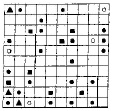
Figure 1 (Understory and Canopy after 5 years)
|
Tree species |
Number of Trees |
% of Total |
|
Yellow birch ○ |
||
|
Aspen ▲ |
||
|
Pin cherry ■ |
||
|
Blackberry ● |
||
|
Sugar Maple □ |
||
|
Beech ◊ |
||
|
TOTAL |

Figure 2 (Understory after 20 Years)
July 1, Noon – air temperature: 75˚F, soil surface temperature: 84˚F
|
Tree species |
Number of Trees |
% of Total |
|
Yellow birch ○ |
||
|
Aspen ▲ |
||
|
Pin cherry ■ |
||
|
Blackberry ● |
||
|
Sugar Maple □ |
||
|
Beech ◊ |
||
|
TOTAL |
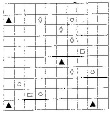
Figure 3 (Understory after 50 Years
July 1, Noon – air temperature: 70˚F, soil surface temperature: 68˚F
|
Tree species |
Number of Trees |
% of Total |
|
Yellow birch ○ |
||
|
Aspen ▲ |
||
|
Pin cherry ■ |
||
|
Blackberry ● |
||
|
Sugar Maple □ |
||
|
Beech ◊ |
||
|
TOTAL |
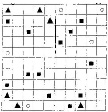
Figure 4 (Canopy after 20 Years)
|
Tree species |
Number of Trees |
% of Total |
|
Yellow birch ○ |
||
|
Aspen ▲ |
||
|
Pin cherry ■ |
||
|
Blackberry ● |
||
|
Sugar Maple □ |
||
|
Beech ◊ |
||
|
TOTAL |
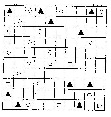
Figure 5 (Canopy after 50 Years)
|
Tree species |
Number of Trees |
% of Total |
|
Yellow birch ○ |
||
|
Aspen ▲ |
||
|
Pin cherry ■ |
||
|
Blackberry ● |
||
|
Sugar Maple □ |
||
|
Beech ◊ |
||
|
TOTAL |
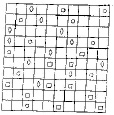
Figure 6 (Canopy after 100 Years)
Procedure B:
Using the data in the tables you just completed, construct two graphs. The first graph will show the changes in the percentage of each tree species in the understory from 5 to 50 years after the hay field was abandoned. The second graph will show the changes in the percentage of each tree species in the canopy from 5 to 100 years after the hay field was abandoned.
Use the percentages of each tree species from figures 1, 2, and 3 to construct your graph of the understory changes.
Use the percentages of each tree species from figures 1, 4, 5 and 6 to construct your graph of the canopy changes.
After completing both graphs, answer the following analysis questions.
1. Describe, in terms of decreasing or increasing percentage, what happened to each of the following tree populations from 5 to 100 years after the field was abandoned:
Yellow birch - ______________________________________________
b. Aspen - _________________________________________________
c. Pin cherry - ______________________________________________
d. Blackberry - _____________________________________________
e. Sugar maple - ____________________________________________
f. Beech - _________________________________________________
2. Using the understory figures 2 and 3, which tree species disappeared between 20 and 50 years after the field was abandoned? (Note: do not include trees that had already disappeared after 20 years.)
__________________________________________________________________________________________________________________________
3. Use the canopy figures 4, 5 and 6 to answer the following questions:
a. Which tree species disappeared between 20 and 50 years after the field was abandoned?
_____________________________________________________________
b. What tree species appeared between 20 and 50 years after the field was abandoned?
_____________________________________________________________
4. What happened to the air temperature and soil surface temperature in the understory between 20 and 50 years after the field was abandoned?
_____________________________________________________________
5. Think about the types of trees growing after 20 years in the understory. Are they tall or short species? ________ Now think about the types of trees growing after 50 years. Are they tall or short species? ________
6. Based on your answers to questions 4 and 5, what caused the change in the air and soil temperature between 20 and 50 years after the field was abandoned?
__________________________________________________________________________________________________________________________
7. In this activity you have observed the changes that occurred in the types of plants that grew in an abandoned hay field over 100 years. What other types of organisms would be affected by the changes that occurred? __________________________________________________________________________________________________________________________
8. Give some examples of organisms (other than plants) that would have lived in the hay field, before it was abandoned. ____________________________________________________________________________________
_____________________________________________________________
9. Would these same organisms live in the abandoned field (now a forest) after 100 years? _______ Why or why not? _________________________________________________________________________________________________________________________________________________
10. Will the community of organisms in the forest change significantly over the next few years? _______ Why or why not? _____________________
__________________________________________________________________________________________________________________________
11. Describe some activities that would cause this forest ecosystem to become a field again. ______________________________________________________________________________________________________________________________________________________________________
12. After such disturbances, would you expect to a forest to become the climax community again? ___________ Why or why not? ________________________________________________________________________________________________________________________________________
13. Make a conclusion of results your work.
TOPICS FOR SEMINAR
Seminar 7
Chapter 7. Components of a biocenosis
1. Biocenosis as a living part of biogeocenosis.
2. Components of a biocenosis.
3. Food chains and food webs.
4. Agrobiocenosis as a man-made form of biocenosis.
Seminar 8
Chapter 8. Ecological relationships
1. Ecological relationships.
2. Neutralism. Examples of neutralism.
3. Types of commensalism.
4. Amensalism as the kind of ecological relationships.
Seminar 9
Chapter 7. The sustainability and dynamics of a biogeocenosis
1. Ecological stability.
2. A biogeocenosis as a dynamic system.
3. Ecological successions.
4. Climax community.
Recommended references:
1. TutorVista // http://biology.tutorvista.com/ecology/tundra.html
2. Mountains // http://www.primaryhomeworkhelp.co.uk/mountains.htm
3. National Geographic // http://science.nationalgeographic.com/science/earth/surface-of-the-earth/mountains-article/
4. Pond Life Animal Printoutshttp: // www.enchantedlearning.com/biomes/pond/pondlife.shtml
5. Five Types of Ecological Relationships // http://education.seattlepi.com/five-types-ecological-relationships-4019.html
TASKS FOR THE CONTROL WORK 3
Identify the letter of the choice that best completes the statement or answers the question.
1. Succession where glaciers melt and expose new rock is called
A. Primary
B. Secondary
C. Tertiary
2. In the following food chain, which organism is the secondary consumer?grass ------> rabbit -------> snake ------> hawk
A. Grass
B. Rabbit
C. Snake
D. Hawk
3. Which of the following cannot be recycled?
A. Nitrogen
B. Carbon
C. Water
D. Energy
4. The release of water vapor from the leaves of trees is called
A. Evaporation
B. Precipitation
C. Condensation
D. Transpiration
5. Sea anemones contain a venom that is used to sting and paralyze their prey. The clownfish contains an enzyme in their scales that makes them immune to the venom. This allows them to freely live in the sea anemone without being harmed. This is an example of what type of relationship?
A. Predator-prey
B. Mutualism
C. Commensalism
D. Parasitism
6. Which of the following is an abiotic factor in an ecosystem?
A. Bird
B. Tree
C. Rock
D. Deer
7. In the food chain “flower – grasshopper (кузнечик) – shrew (землеройка) – snake (змея) – owl (сова)”, the snake is an example of a
A. Producer
B. Primary consumer
C. Secondary consumer
D. Tertiary consumer
8. Mushrooms and other fungi are responsible for breaking down dead organic matter. In the ecosystem, they are called
A. Producers
B. Consumers
C. Decomposers
D. Scavengers
9. The amount of energy that is passed from one organism to the next in a food chain is
A. 5%
B. 10%
C. 15%
D. 20%
10. On what trophic level would you find organisms that use the sun’s energy directly to make their own food?
A. 1
B. 2
C. 3
D. 4
11. Lichen is a symbiotic decomposer that attachers itself to trees and slowly breaks them down. They obtain nutrients from the tree, allowing them to survive and reproduce. What type of relationship is this?
A. Predator-prey
B. Mutualism
C. Parasitism
D. Competition
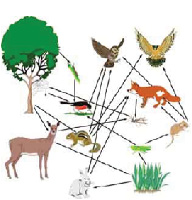
12. In the terrestrial food web above, what would be the effect of a farmer introducing a rat poison in to the ecosystem that is toxic to rats and mice?
A. The population of fox would decrease
B. The population of grasshoppers would decrease
C. The population of hawks would increase
D. The population of rabbits would decrease
13. An animal that only eats the flesh of another animal is called a
A. Producer
B. Herbivore
C. Carnivore
D. Omnivore
14. Which of the following statements is true about matter and energy?
A. Matter is not recycled; energy is recycled
B. Matter is recycled; energy is not recycled
C. Both matter and energy are recycled
D. Neither matter nor energy are recycled
15. The ultimate source of energy for all organisms in life is
A. Water
B. Oxygen
C. Nitrogen
D. The sun
16. In the nitrogen cycle, the term «denitrification» refers to
A. The conversion of ammonia into nitrogen
B. The conversion of nitrogen into ammonia
C. The conversion of nitrates into nitrogen gas
D. The conversion of nitrogen gas into nitrates
17. Which of the following is considered the main source of excess carbon dioxide in the atmosphere leading to the destruction of the ozone layer?
A. Carbon gas released into the atmosphere from factories and cars
B. Carbon dioxide being released from animals during the process of cellular respiration
C. Carbon gas released into the soil through the process of decomposition
D. Carbon dioxide released into the oceans during deposition and decomposition

18. What type of relationship does the above image represent?
A. Competition
B. Mutualism
C. Parasitism
D. Predator-prey
19. Which of the following organisms is an autotroph?
A. Algae
B. A bear
C. A cheetah
D. A fish
20. An area was recently destroyed by a raging wildfire. Which of the following events would allow secondary succession to take place?
A. Animals that survive migrate to surrounding areas
B. Plant life that survive begin to die out as a result of the lack of available nutrients
C. The dead bodies of animals that did not survive the fire return nutrients to the soil
D. Omnivores that survive create a decline of both the herbivore and carnivore population
21. What term describes a consumer?
A. Heterotroph
B. Autotroph
C. Producer
D. Chemosynthetic
22. What kind of organism provides the basis for an ecosystem’s energy?
A. Heterotroph
B. Autotroph
C. Consumer
D. Scavenger
23. What organism is in the second trophic level in the following food chain: producer-herbivore-omnivore-carnivore?
A. Carnivore
B. Herbivore
C. Omnivore
D. Producer
24. How does oxygen enter the atmosphere in the oxygen cycle?
A. Plants release oxygen to the atmosphere as a waste product of photosynthesis
B. Animals release oxygen to the atmosphere as a waste product of photosynthesis.
C. Oxygen enters the atmosphere as carbon dioxide from photosynthesis
D. Plants release oxygen to the atmosphere as a waste product of cellular respiration.

25. In the ecosystem shown in the picture, which of the following is an example of an abiotic factor?
A. Mushrooms
B. Tree roots
C. Sunlight
D. Fish
26. Which of the following is thought to contribute to global warming?
A. Increased levels of greenhouse gases emitted from human sources
B. Increased water vapor in the atmosphere
C. Decreased amounts of carbon dioxide in the atmosphere
D. Heat reflected from solar panels
27. Which of the following is an example of parasitism?
A. Bees gathering nectar from a patch of flowers
B. A barnacle living on the underside of a whale
C. A brown-headed cowbird laying its egg in a vireo’s nest
D. A flea feeding on the blood of a dog
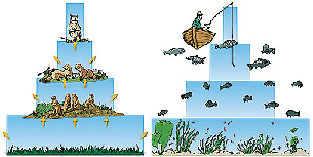
28. Why do energy pyramids and biomass pyramids usually have a similar shape?
A. An energy pyramid cannot contain more energy than organisms need
B. As energy is lost, more biomass can be supported
C. The amount of biomass on any level cannot be greater than the available energy can support
D. Both energy and biomass are lost to the environment at equal rates
29. Why is so much energy lost from one trophic level to another?
A. Organisms must use energy to warm their bodies
B. Organisms stop growing as adults, so they don’t need all the energy they take in.
C. Cellular respiration is an efficient process
D. The conversion of biomass from one organism to another is inefficient
30. Which of the following is usually found in the smallest number in a pyramid of numbers?
A. Producers
B. Primary consumers
C. Secondary consumers
D. Tertiary consumers
31. Why don’t most parasites kill their hosts immediately?
A. The parasites would no longer have a food supply if the host died.
B. The host is able to fight off the invading parasites.
C. The host benefits by keeping the parasites alive.
D. The parasites help the host before killing it.
32. A pack of wolves is fighting with a grizzly bear over a kill. What kind of competition is this?
A. Interspecific competition
B. Intraspecific competition
C. Predation
D. Symbiotic competition
33. Lichens are a combination of algae and fungus that grow on rocks. What kind of symbiosis is this?
A. Commensalism
B. Mutualism
C. Parasitism
D. Predation
34. An intestinal worm is endoparasite and a tick is ectoparasite. How are endoparasites and ectoparasites alike?
A. Both feed on the host’s fluids.
B. Both feed on nutrients that are ingested by the host.
C. Both live in the tissues and organs of the host.
D. Both kill their host.
35. Burning coal in a power plant would be part of which cycle?
A. Nitrogen cycle
B. Water cycle
C. Carbon cycle
D. Phosphorous cycle
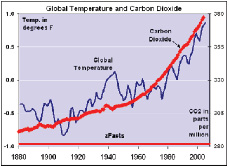
36. Which of the following is a cause and effect relationship that seems to be supported by the graph?
A. Carbon dioxide levels have no effect on average global temperatures.
B. As carbon dioxide levels increase, average global temperatures decrease.
C. As carbon dioxide levels increase, average global temperatures increase.
D. As average global temperatures increase, carbon dioxide levels decrease.
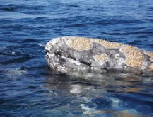
37. Barnicles live on the backs of many whales. What kind of symbiotic relationship is this?
A. Mutualism
B. Parasitism
C. Commensalism
38. Two male lions fight for the same female. What kind of competition is this?
A. Interspecific competition
B. Intraspecific competition
C. Predation
D. Symbiotic competition
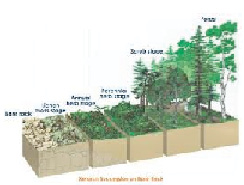
39. The process shown in the figure above is?
A. Symbiosis
B. Oligotrophy
C. Succession
D. Competitive exclusion
40. What kind of ecological succession occurs after a fire?
A. Primary succession
B. Secondary succession
C. Tertiary succession
D. Quaternary succession
